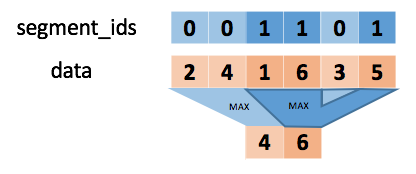mindspore.ops.unsorted_segment_max
- mindspore.ops.unsorted_segment_max(x, segment_ids, num_segments)[source]
Compute the maximum of the input tensor along segments.
The following figure shows the calculation process of unsorted_segment_max:
 \[\text { output }_i=\text{max}_{j \ldots} \text { data }[j \ldots]\]
\[\text { output }_i=\text{max}_{j \ldots} \text { data }[j \ldots]\]where \(max\) over tuples \(j...\) such that \(segment\_ids[j...] == i\).
Note
If the segment_id i is absent in the segment_ids, then output[i] will be filled with the minimum value of the x's type.
The segment_ids must be non-negative tensor.
- Parameters
- Returns
Tensor
- Supported Platforms:
AscendGPUCPU
Examples
>>> import mindspore >>> x = mindspore.tensor([[1, 2, 3], [4, 5, 6], [4, 2, 1]]) >>> segment_ids = mindspore.tensor([0, 1, 1]) >>> num_segments = 2 >>> mindspore.ops.unsorted_segment_max(x, segment_ids, num_segments) Tensor(shape=[2, 3], dtype=Int64, value= [[1, 2, 3], [4, 5, 6]])